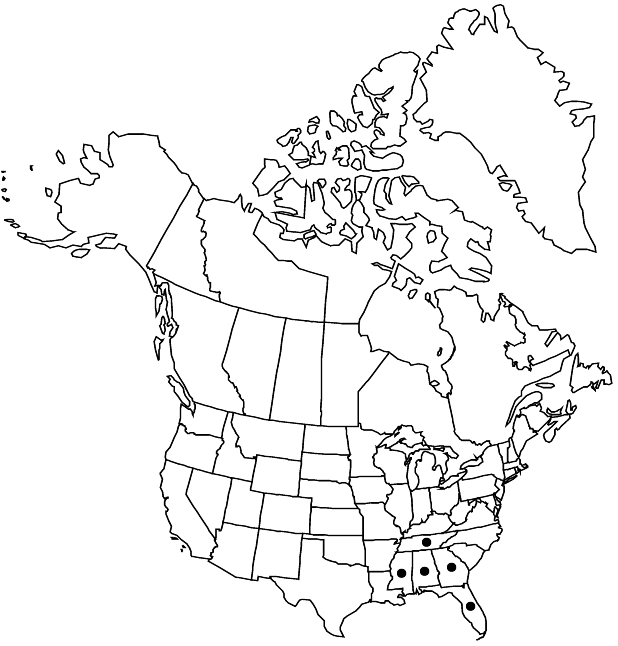Rhododendron alabamense
in E. H. Wilson and A. J. Rehder, Monogr. Azaleas, 141. 1921 ,.
Shrubs, to 3 (–5) m, usually not rhizomatous. Stems: bark smooth to vertically furrowed, shredding; twigs scattered, multicellular eglandular-hairy (hairs unbranched), otherwise glabrous or moderately unicellular-hairy. Leaves deciduous; petiole unicellular and stipitate-glandular-hairy; blade ovate to obovate, 4–7.7 (–9.4) × 1.2–2.5 (–3.3) cm, thin, membranous, margins entire, plane, ciliate, eglandular-hairy, apex acute to obtuse, often mucronate, abaxial surface glabrous or unicellular-hairy, adaxial surface usually scattered eglandular-hairy, usually also unicellular-hairy. Floral bud-scales glabrous or glabrate abaxially, margins unicellular-ciliate. Inflorescences 6–7-flowered; bracts similar to bud-scales. Pedicels 4–12 mm, eglandular and/or stipitate-glandular-hairy, otherwise glabrous or moderately unicellular-hairy. Flowers opening before or with leaves, erect to horizontal, very fragrant; calyx lobes 0.1–3 mm, scattered eglandular-hairy and/or stipitate-glandular-hairy, otherwise sparsely to moderately unicellular-hairy, margins eglandular-hairy; corolla white, sometimes pink-tinged, with contrasting yellow blotch on upper lobe, funnelform, 25–42 mm, scattered stipitate-glandular-hairy (hairs often continuing in lines up lobes), otherwise sparsely to moderately unicellular-hairy on outer surface, petals connate, lobes 9–21 mm, tube usually ± gradually expanded into lobes, 15–31 mm (longer than lobes); stamens 5, much exserted, ± unequal, 37–69 mm. Capsules borne on erect pedicels, 14–22 × 3–4 mm, sparsely to moderately multicellular eglandular-hairy, otherwise moderately to densely unicellular-hairy. Seeds without distinct tails; testa expanded, dorsiventrally flattened, ± loose. 2n = 26.
Phenology: Flowering spring.
Habitat: Open, dry woodlands, rocky slopes
Elevation: 0-500 m
Distribution

Ala., Fla., Ga., Miss., Tenn.
Discussion
Rhododendron alabamense may be most closely related to a clade containing orange-red-flowered species (K. A. Kron 1993). This species has sometimes been confused with R. eastmanii; R. alabamense flowers before or as the leaves expand whereas R. eastmanii flowers after the leaves have expanded. Hybrids with R. canescens are known.
Selected References
None.
Lower Taxa
No values specified.